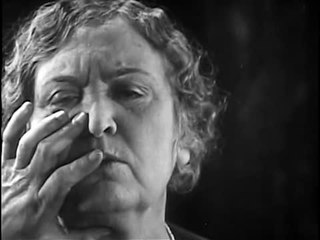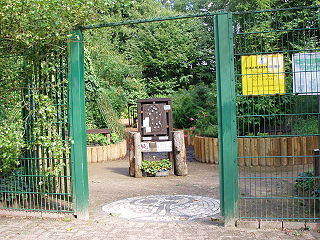
Tadoma is a method of communication utilized by deafblind individuals, in which the listener places their little finger on the speaker's lips and their fingers along the jawline. The middle three fingers often fall along the speaker's cheeks with the little finger picking up the vibrations of the speaker's throat. It is sometimes referred to as tactile lipreading, as the listener feels the movement of the lips, the vibrations of the vocal cords, expansion of the cheeks and the warm air produced by nasal phonemes such as 'N' and 'M'. Hand positioning can vary, and it is a sometimes also used by hard-of-hearing people to supplement their remaining hearing.
This is a glossary of medical terms related to communication disorders which are psychological or medical conditions that could have the potential to affect the ways in which individuals can hear, listen, understand, speak and respond to others.

Haptic technology is technology that can create an experience of touch by applying forces, vibrations, or motions to the user. These technologies can be used to create virtual objects in a computer simulation, to control virtual objects, and to enhance remote control of machines and devices (telerobotics). Haptic devices may incorporate tactile sensors that measure forces exerted by the user on the interface. The word haptic, from the Ancient Greek: ἁπτικός (haptikos), means "tactile, pertaining to the sense of touch". Simple haptic devices are common in the form of game controllers, joysticks, and steering wheels.
Stimulus modality, also called sensory modality, is one aspect of a stimulus or what is perceived after a stimulus. For example, the temperature modality is registered after heat or cold stimulate a receptor. Some sensory modalities include: light, sound, temperature, taste, pressure, and smell. The type and location of the sensory receptor activated by the stimulus plays the primary role in coding the sensation. All sensory modalities work together to heighten stimuli sensation when necessary.
Deafblindness is the condition of little or no useful hearing and little or no useful sight. Different degrees of vision loss and auditory loss occur within each individual. Because of this inherent diversity, each deafblind individual's needs regarding lifestyle, communication, education, and work need to be addressed based on their degree of dual-modality deprivation, to improve their ability to live independently. In 1994, an estimated 35,000–40,000 United States residents were medically deafblind. Laura Bridgman was the first American deafblind person known to become well educated. Helen Keller was a well-known example of an educated deafblind individual. To further her lifelong mission to help the deafblind community to expand its horizons and gain opportunities, the Helen Keller National Center for Deaf-Blind Youths and Adults, with a residential training program in Sands Point, New York, was established in 1967 by an act of Congress.

A sensory garden is a self-contained garden area that allows visitors to enjoy a wide variety of sensory experiences. Sensory gardens are designed to provide opportunities to stimulate the senses, both individually and in combination, in ways that users may not usually encounter.
Tactile signing is a common means of communication used by people with deafblindness. It is based on a sign language or another system of manual communication.
Sensory substitution is a change of the characteristics of one sensory modality into stimuli of another sensory modality.
A touch user interface (TUI) is a computer-pointing technology based upon the sense of touch (haptics). Whereas a graphical user interface (GUI) relies upon the sense of sight, a TUI enables not only the sense of touch to innervate and activate computer-based functions, it also allows the user, particularly those with visual impairments, an added level of interaction based upon tactile or Braille input.
Tactile discrimination is the ability to differentiate information through the sense of touch. The somatosensory system is the nervous system pathway that is responsible for this essential survival ability used in adaptation. There are various types of tactile discrimination. One of the most well known and most researched is two-point discrimination, the ability to differentiate between two different tactile stimuli which are relatively close together. Other types of discrimination like graphesthesia and spatial discrimination also exist but are not as extensively researched. Tactile discrimination is something that can be stronger or weaker in different people and two major conditions, chronic pain and blindness, can affect it greatly. Blindness increases tactile discrimination abilities which is extremely helpful for tasks like reading braille. In contrast, chronic pain conditions, like arthritis, decrease a person's tactile discrimination. One other major application of tactile discrimination is in new prosthetics and robotics which attempt to mimic the abilities of the human hand. In this case tactile sensors function similarly to mechanoreceptors in a human hand to differentiate tactile stimuli.
Tangible symbols are a type of augmentative and alternative communication (AAC) that uses objects or pictures that share a perceptual relationship with the items they represent as symbols. A tangible symbol's relation to the item it represents is perceptually obvious and concrete – the visual or tactile properties of the symbol resemble the intended item. Tangible Symbols can easily be manipulated and are most strongly associated with the sense of touch. These symbols can be used by individuals who are not able to communicate using speech or other abstract symbol systems, such as sign language. However, for those who have the ability to communicate using speech, learning to use tangible symbols does not hinder further developing acquisition of natural speech and/or language development, and may even facilitate it.

The somatosensory system, or somatic sensory system is a subset of the sensory nervous system. It has two subdivisions, one for the detection of mechanosensory information related to touch, and the other for the nociception detection of pain and temperature. The main functions of the somatosensory system are the perception of external stimuli, the perception of internal stimuli, and the regulation of body position and balance (proprioception).
Many types of sense loss occur due to a dysfunctional sensation process, whether it be ineffective receptors, nerve damage, or cerebral impairment. Unlike agnosia, these impairments are due to damages prior to the perception process.

Tactile hallucination is the false perception of tactile sensory input that creates a hallucinatory sensation of physical contact with an imaginary object. It is caused by the faulty integration of the tactile sensory neural signals generated in the spinal cord and the thalamus and sent to the primary somatosensory cortex (SI) and secondary somatosensory cortex (SII). Tactile hallucinations are recurrent symptoms of neurological diseases such as schizophrenia, Parkinson's disease, Ekbom's syndrome and delirium tremens. Patients who experience phantom limb pains also experience a type of tactile hallucination. Tactile hallucinations are also caused by drugs such as cocaine and alcohol.

Na Laga'at is a nonprofit organization founded in 2002 by Adina Tal and Eran Gur around the first of its kind in the world ensemble whose actors are all deafblind. The organization established a unique cultural center at the Levantbondet House in the Port of Jaffa in Tel Aviv. The center is a platform for creative arts, which promotes equal and open dialogue and leads to social change built on the belief in the human spirit and its ability to reach out and make a change.

Sensory processing disorder (SPD), formerly known as sensory integration dysfunction, is a condition in which multisensory input is not adequately processed in order to provide appropriate responses to the demands of the environment. Sensory processing disorder is present in many people with dyspraxia, autism spectrum disorder, and attention deficit hyperactivity disorder (ADHD). Individuals with SPD may inadequately process visual, auditory, olfactory (smell), gustatory (taste), tactile (touch), vestibular (balance), proprioception, and interoception sensory stimuli.
Tactile technology is the integration of multi-sensory triggers within physical objects, allowing "real world" interactions with technology. It is similar to haptic technology, as both focus on touch interactions with technology, but whereas haptic is simulated touch, tactile is physical touch. Rather than using a digital interface to interact with the physical world, as augmented reality does, tactile technology involves a physical interaction that triggers a digital response.
Vincent Hayward, was a scientist and engineer. His reaserch focus was on touch and haptics. He was a professor at Sorbonne University, Institute of Intelligent Systems and Robotics (ISIR), where since 2008 he led a team dedicated to the study of tactile perception and the development of haptic devices. In 2020, he was elected to the French Academy of sciences.
Protactile is a language used by deafblind people using tactile channels. Unlike other sign languages, which are heavily reliant on visual information, protactile is oriented towards touch and is practiced on the body. Protactile communication originated out of communications by DeafBlind people in Seattle in 2007 and incorporates signs from American Sign Language. Protactile is an emerging system of communication in the United States, with users relying on shared principles such as contact space, tactile imagery, and reciprocity.






